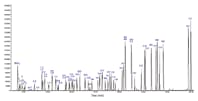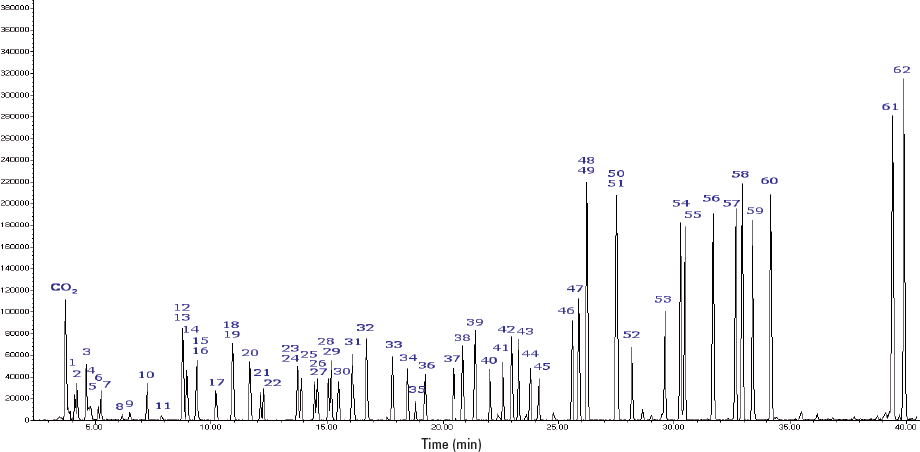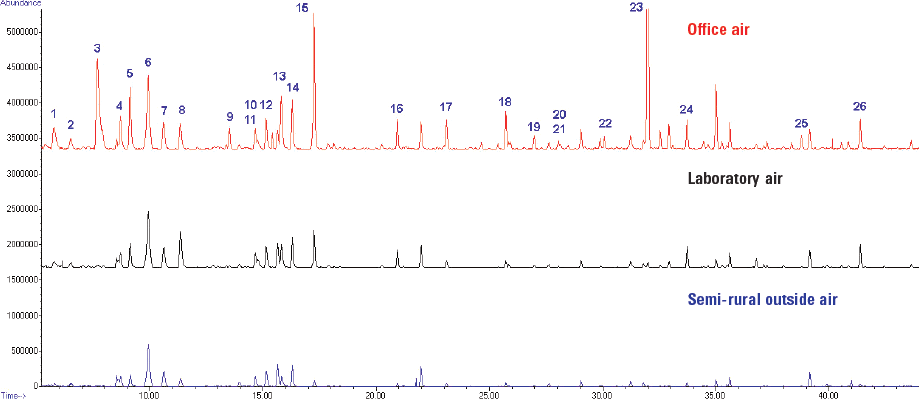Access Agilent eNewsletter, July 2014
>> Update My Profile | Subscribe to Access Agilent | Article Directory

Solutions for air sampling and analysis
By Lakshmi Krishnan
Agilent Global Marketing Program Manager
Volatile organic compounds (VOCs) are monitored worldwide in many industrial and urban environments as a measure of air quality. These compounds range in volatility from methyl chloride to hexachlorobutadiene and trichlorobenzenes. National and international standard methods have been developed for air toxics and related compounds, including U.S. EPA Method TO-15 for VOCs collected in canisters [1] and EPA Method TO-17 for VOCs collected onto sorbent tubes [2]. In response to the increasing demand for ambient air toxicity measurement, cryogen-free thermal desorption technologies have been developed which offer an automated, method-compliant analytical platform for both canisters and sorbent tubes.
In this article, we focus on the two most commonly used methods using cryogen-free approaches that take advantage of the capabilities offered by Agilent air monitoring systems.
 Enlarge
Enlarge
Figure 1. 1 L of a 1 ppb air toxics standard analyzed splitless using an Agilent J&W DB-624 column. Note the narrow Gaussian peak shapes.
TO-15 with air canisters
In this example, we use an Agilent TO-15 system comprising a Markes International UNITY 2 thermal desorber (TD) and Canister Interface coupled to a 7890B GC and 5977A GC/MSD, with an Agilent J&W DB-624 GC column used for the chromatography. This configuration provides a quantitative recovery of target compounds, while reducing the damaging effects of water on the analysis. A 62-component 1 ppm TO-15 gas standard in nitrogen was introduced into the canister. Once the process of transferring a quantitative sample from the canister to the focusing trap was complete, the trap was purged with dry carrier gas in the sampling direction to remove residual water. The flow of carrier gas was then reversed and the trap heated rapidly. At this point the retained organics were desorbed into the carrier gas stream and transferred into the GC analytical column. The full scan, total ion chromatogram from this analysis is shown in Figure 1. Note the flatness of the baseline and lack of interferences or baseline anomalies.
Results show quantitative detection of TO-15 air toxics ranged from methyl chloride to hexachloro-1,3-butadiene at levels down to 0.1 ppb in canisters. Even lower levels could be comfortably achieved by using the GC/MS in selected ion mode (SIM). Read the full details of these experiments in Agilent Application Note 5991-2829EN.
 Enlarge
Enlarge
Figure 2. Chromatograms from three 1-L real air samples collected using sorbent tubes and desorbed splitless before injection into an Agilent J&W DB-624 GC column.
TO-17 with sorbent tubes
For this method, identical hardware and software was used as in the previous example, except for the SUMMA canister. An air sample was pumped directly onto sorbent tubes and the same mix of sorbents was employed (Tenax, CarboPackX, and Carboxen 1003) Minimum detection limits were found to be below 0.1 ppb for all 62 components tested under 10:1 split and splitless conditions, assuming a minimum 1 L air/gas sample volume and the GC/MS operating in full scan mode.
We then proceeded to measure ambient air in three different environments; office, laboratory, and semi-rural outdoors. Each sample tube was analyzed splitless using a full-scan GC/MS method operating from 10 to 300 amu. The resulting chromatograms are shown in Figure 2, and a complete description of the work is available in Agilent Application Note 5991-2828EN.
Air analysis solutions from Agilent and Markes
Agilent’s high quality 5977A series GC/MSD, 7890B GC system, and Agilent J&W GC columns, matched with the Markes UNITY Thermal Desorber, form a complete air analysis solution that meets the challenges faced by analysts in keeping up with evolving regulatory requirements. Explore and discover more Agilent and Markes’ solutions for effective air analysis. We also offer a new air monitoring poster, which lays out the fundamentals you need to perform reliable tests of air quality.
Acknowledgment
We thank Markes International Ltd for use of the chromatograms and supporting text.
References
- Anon. Determination of volatile organic compounds in air collected in SUMMA canisters and analyzed by GC/MS. Compendium Method TO-15. U.S. Environmental Protection Agency, Cincinnati, OH (1999).
- Anon. Determination of volatile organic compounds in ambient air using active sampling onto sorbent tubes. Compendium Method TO-17. U.S. Environmental Protection Agency, Cincinnati, OH (1999).
>> Update My Profile | Subscribe to Access Agilent | Article Directory

